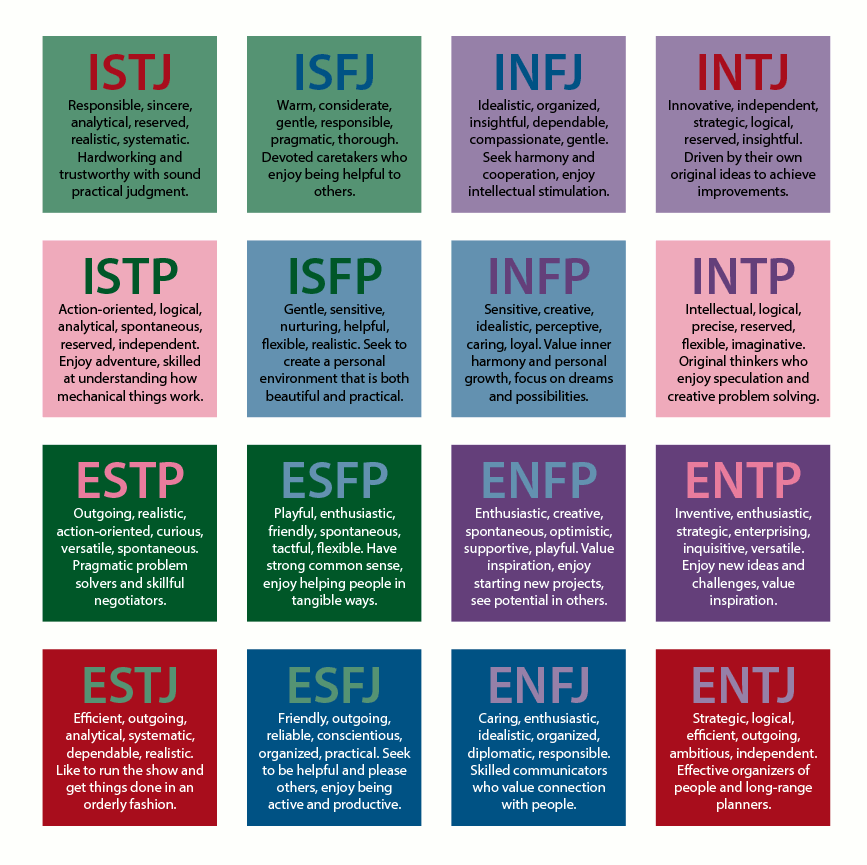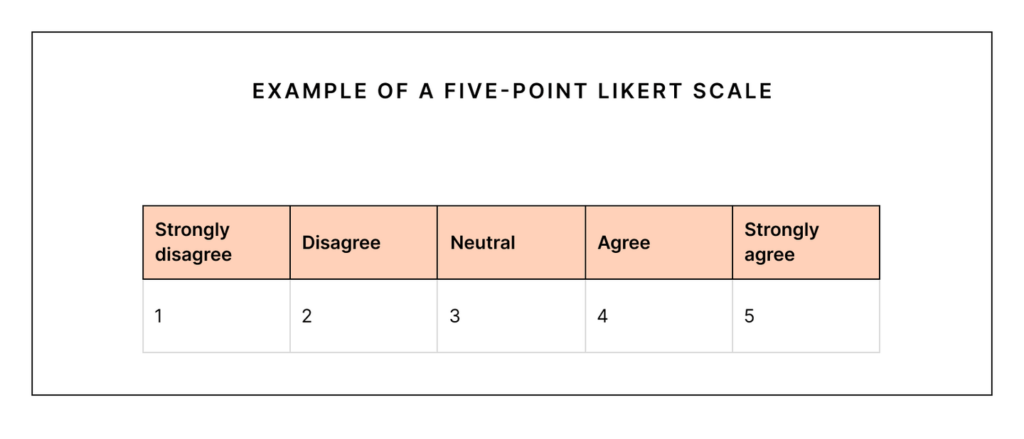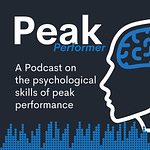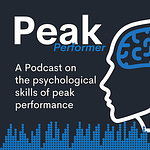Welcome to this week’s edition of the podcast. If you like what I’m doing here, share this episode with a friend, post a comment. Many thanks for your support!
The Myers-Briggs Type Indicator (MBTI) is one of the most popular personality tests in the world. Developed by Katharine Cook Briggs and her daughter Isabel Briggs Myers and based upon Carl Jung's work, it categorises individuals into 16 distinct types based on four dichotomies: Introversion vs Extraversion, Sensing vs Intuition, Thinking vs Feeling, and Judging vs Perceiving. Despite its widespread use in a variety of settings and its apparent utility (Pittenger, 1993)1, from corporate team-building to personal self-discovery, the MBTI has faced significant criticism from the scientific community.
Although influential, Jung's work is mainly considered speculative (Mayer, 2005)2 and not subjected to rigorous scientific testing. His typology was derived from clinical observations rather than systematic research, making it a weak foundation for a personality assessment tool. In contrast, modern personality psychology relies on empirical studies to validate theoretical constructs and measurement instruments.
The MBTI Dichotomies And Why There Problems
Myers Briggs Type Indicator (MBTI) is structured around four pairs of opposing preferences, resulting in 16 unique personality types. Here's a closer look at each dichotomy:
Introversion (I) vs. Extraversion (E): This dimension reflects where individuals draw their energy from. Solitary activities energise introverts, while extraverts thrive in social settings.
Sensing (S) vs. Intuition (N): This dichotomy pertains to how people perceive information. Sensors focus on concrete, factual information, whereas intuitive types look for patterns and abstract possibilities.
Thinking (T) vs. Feeling (F): This axis relates to decision-making processes. Thinkers prioritise logic and objective criteria, while feelers consider personal values and their impact on others.
Judging (J) vs Perceiving (P): This preference describes one's approach to the external world. Judging types prefer structure and decisiveness, whereas perceiving types are more flexible and spontaneous.
While these categories can offer some insights into personality, their scientific validity and reliability are hotly debated.
Problem 1: Lack of Scientific Validity and Reliability
One of the main criticisms of the Myers-Briggs Type Indicator (MBTI) is its lack of scientific validity and reliability. Scientific validity concerns the extent to which a test measures what it purports to measure. In the case of the MBTI, research suggests it fails to assess personality traits accurately, as claimed. Reliability refers to the consistency of test results over time. Studies have shown that individuals often receive different personality type results when taking the test multiple times, indicating poor reliability (Pittenger, 1993). Costa & McCrae (1989), in their analysis of MBTI, found significant deficiencies. For example, the MBTI does not encompass all major dimensions of personality, unlike the Big Five. MBTI overlooks the Openness to Experience trait entirely, according to their research.
Problem 2: Inconsistent Results
Low test-retest reliability indicates that individuals often receive different MBTI results upon retesting (Boyle, 1995). This inconsistency undermines the MBTI's credibility as a stable measure of personality, as a reliable test should yield consistent results over time. If a person’s type changes with each administration, it casts doubt on the test's ability to accurately capture enduring personality traits. This instability suggests that the MBTI may not be a dependable tool for making significant personal or professional decisions based on personality assessment.
Problem 3: Absence of Predictive Validity
Another issue with the MBTI is its limited predictive validity, meaning it struggles to accurately forecast future behaviours or outcomes based on its personality categories. Research has shown that the MBTI is not effective at predicting job performance, career success, or personal satisfaction. This limitation arises because the MBTI does not account for the complexities and nuances of personality traits as effectively as more scientifically robust models, such as the Big Five. Consequently, the MBTI's utility in practical applications, like employment selection or personal development, is significantly diminished. (Pittenger, 1993); Furnham, 1996)3.
Problem 4: Dichotomous Scales
The MBTI's ipsative format (forced-choice) requires respondents to choose between two options for each question or statement. This oversimplifies the complexity of human personality because you may agree or disagree with the options offered —the measure presents a false dichotomy. This dichotomous approach fails to recognise that most personality traits exist on a continuum or within a constellation rather than as binary choices. Life is not this simple, unfortunately. For instance, an individual might exhibit both introverted and extraverted behaviours depending on the situation, a nuance the MBTI does not capture. By forcing individuals into rigid categories, the MBTI overlooks the true variability and richness of personality, limiting its accuracy and effectiveness (Costa & McCrae, 1989).
Problem 5: Real-World Implications
The MBTI's oversimplification can have significant real-world implications, especially in contexts such as career counselling, employee selection, and personal development. By categorising individuals into rigid personality types, it may lead to mismatches between people and their roles, potentially causing job dissatisfaction, reduced performance, and missed opportunities for personal growth. Furthermore, the forced-choice format can perpetuate stereotypes and limit the understanding of an individual's full range of abilities and traits, thus impacting decisions made in educational and professional settings (Pettinger, 1993).
Problem 6: Outdated Theoretical Foundations
The MBTI is based on Carl Jung's theories of psychological types, formulated in the early 20th century. While Jung's ideas were groundbreaking at the time, they lacked empirical support by modern scientific standards. Contemporary psychology favours evidence-based models grounded in extensive research and data.
Since Jung's time, personality psychology has evolved significantly. Researchers have developed more sophisticated models that are supported by extensive empirical data. These models consider the complexity and variability of human personality, offering a more accurate and comprehensive understanding than the MBTI.
The Big 5: A More Substantial Alternative to The MBTI
The scientific community has been largely critical of the MBTI and has proven more in favour of methodologically and structurally robust personality models. One such model is the Big Five personality traits, also known as the Five-Factor Model (FFM). Many researchers have worked on the Five-Factor Model of personality, including Costa & McCrae (1989)4 and Lewis Goldberg (1999)5. The Big Five (with the acronym OCEAN) includes the following dimensions:
Openness to Experience
Openness to Experience describes a dimension of cognitive style that distinguishes imaginative, creative people from down-to-earth, conventional people. Open people are intellectually curious, appreciative of art, and sensitive to beauty. Compared to closed people, they tend to be more aware of their feelings. They tend to think and act in individualistic and nonconforming ways. Intellectuals typically score high on Openness to Experience; this factor has also been called Culture or Intellect. Nonetheless, Intellect is probably best regarded as one aspect of openness to Experience. Scores on Openness to Experience are only modestly related to years of education and scores on standard intelligence tests.
Another characteristic of the open cognitive style is a facility for thinking in symbols and abstractions far removed from concrete Experience. Depending on the individual's specific intellectual abilities, this symbolic cognition may be mathematical, logical, or geometric thinking, artistic and metaphorical use of language, music composition or performance, or one of the many visual or performing arts. People with low scores on Openness to Experience tend to have narrow, common interests. They prefer the plain, straightforward, and obvious over the complex, ambiguous, and subtle. They may regard the arts and sciences with suspicion, regarding these endeavours as abstruse or of no practical use. Closed people prefer familiarity over novelty; they are conservative and resistant to change. Facets of Openness include;
Imagination
Artistic Interests
Emotionality
Adventurousness
Intellect
Liberalism
Conscientiousness
Conscientiousness concerns how we control, regulate, and direct our impulses. Impulses are not inherently bad; occasionally, time constraints require a snap decision, and acting on our first impulse can be an effective response. Also, acting spontaneously and impulsively can be fun in times of play rather than work. Others can see impulsive individuals as colourful, fun to be with, and zany. Nonetheless, acting on impulse can lead to trouble in several ways. Some impulses are antisocial. Uncontrolled antisocial acts not only harm other members of society but also can result in retribution toward the perpetrator of such impulsive acts.
Another problem with impulsive acts is that they often produce immediate rewards but undesirable, long-term consequences. Examples include excessive socializing that leads to being fired from one's job, hurling an insult that causes the breakup of a meaningful relationship, or using pleasure-inducing drugs that eventually destroy one's health. Impulsive behaviour, even when not seriously destructive, significantly diminishes a person's effectiveness. Acting impulsively disallows contemplating alternative courses of action, some of which would have been wiser than the impulsive choice. Impulsivity also sidetracks people during projects that require organized sequences of steps or stages. An impulsive person's accomplishments are, therefore, small, scattered, and inconsistent. Facets of Conscientiousness include;
Self-efficacy
Orderliness
Dutifulness
Achievement-striving
Self-discipline
Cautiousness
Extraversion
Extraversion is marked by pronounced engagement with the external world. Extraverts enjoy being with people, are full of energy, and often experience positive emotions. They tend to be enthusiastic, action-oriented individuals who are likely to say “Yes!” or “Let's go!” to opportunities for excitement. In groups, they like to talk, assert themselves, and draw attention to themselves. Introverts lack the exuberance, energy, and activity levels of extroverts. They tend to be quiet, low-key, deliberate, and disengaged from the social world.
Their lack of social involvement should not be interpreted as shyness or depression; the introvert needs less stimulation than an extravert and prefers to be alone. The independence and reserve of the introvert is sometimes mistaken as unfriendliness or arrogance. In reality, an introvert who scores high on the agreeableness dimension will not seek others out but will be quite pleasant when approached. Facets of Extraversion include;
Friendliness
Gregariousness
Assertiveness
Activity Level
Excitement-seeking
Cheerfulness
Agreeableness
Agreeableness reflects individual differences in concern with cooperation and social harmony. Agreeable individuals value getting along with others. They are, therefore, considerate, friendly, generous, helpful, and willing to compromise their interests with others. Agreeable people also have an optimistic view of human nature. They believe people are basically honest, decent, and trustworthy. Disagreeable individuals prioritise self-interest over getting along with others. They are generally unconcerned with others' well-being and, therefore, are unlikely to extend themselves to others.
Sometimes, their scepticism about others' motives causes them to be suspicious, unfriendly, and uncooperative. Agreeableness is advantageous for attaining and maintaining popularity. Agreeable people are better liked than disagreeable people. On the other hand, agreeableness is not helpful in situations that require tough or absolute objective decisions. Disagreeable people can make excellent scientists, critics, or soldiers. Facets of Agreeableness include;
Trust
Morality
Altruism
Cooperation
Modesty
Sympathy
Neuroticism
Freud initially used the term neurosis to describe a condition marked by mental distress, emotional suffering, and an inability to cope effectively with the everyday demands of life. He suggested that everyone shows some signs of neurosis but that we differ in our degree of suffering and our specific symptoms of distress. Today, Neuroticism refers to the tendency to experience negative feelings. Those who score high on Neuroticism may experience primarily one specific negative feeling, such as anxiety, anger, or depression, but are likely to experience several of these emotions.
People high in Neuroticism are emotionally reactive. They respond emotionally to events that would not affect most people, and their reactions tend to be more intense than usual. They are more likely to interpret ordinary situations as threatening and minor frustrations as hopelessly complex. Their adverse emotional reactions tend to persist for unusually long periods, which means they are often in a bad mood. These problems in emotional regulation can diminish a neurotic's ability to think, make decisions, and cope effectively with stress.
At the other end of the scale, individuals who score low in Neuroticism are less easily upset and are less emotionally reactive. They tend to be calm, emotionally stable, and free from persistent negative feelings. Freedom from negative feelings does not mean that low scorers experience many positive feelings; the frequency of positive emotions is a component of the Extraversion domain. Facets of Neuroticism include;
Anxiety
Anger
Depression
Self-consciousness
Immoderation
Vulnerability
Empirical Support for the Big Five
The Big Five model is supported by extensive research and is considered the gold standard in personality psychology. Numerous studies have demonstrated its reliability and validity across different cultures and populations. Unlike the MBTI, the Big Five traits are measured on a continuum, providing a more accurate and nuanced understanding of personality.
Practical Applications
The Big Five has practical applications in various fields, including psychology, organisational behaviour, and personal development. It has been shown to predict important outcomes, such as job performance, academic success, and interpersonal relationships. This evidence-based approach contrasts sharply with the MBTI's more anecdotal and less scientifically grounded methodology.
The Appeal of the MBTI
Despite its scientific shortcomings, the MBTI's popularity persists (Grant, 2013)6. Understanding the reasons behind its widespread use can show why it continues to be a favoured tool for many. The MBTI's straightforward format makes it accessible to a broad audience. Its dichotomous questions are easy to understand, and the resulting personality types are simple to interpret and assign to oneself. This ease of use appeals to individuals and organisations looking for quick insights into personality.
Many people find the MBTI appealing because it offers a form of personal validation. The descriptions of the 16 personality types are often phrased positively, highlighting strengths and potential areas for growth. This positive framing can make individuals feel understood and appreciated. We have seen here that the scientific basis for its use is, at best, weak. The MBTI and other “type” approaches to personality, such as the DISC and others, are little more than a horoscope.
The MBTI has a long history and has become embedded in various cultural and organisational practices. Its widespread adoption in educational and corporate settings has created a sense of legitimacy, making it a default choice for personality assessment in many contexts. However, while the MBTI offers some insights and has its place in popular culture, moving towards evidence-based models like the Big Five can provide more accurate and reliable personality assessments.
The Need For Evidence-Based Models
With the need to accurately predict outcomes, individuals and organisations must make informed, evidence-based decisions about which personality assessments to use. By promoting evidence-based models, we can improve the quality of personality research and its applications, and organisations can benefit from integrating the Big Five model into their practices. For instance, using the Big Five for recruitment and team-building can improve outcomes by providing a more nuanced understanding of employees' strengths and weaknesses. This approach can enhance organisational effectiveness and employee satisfaction (Barrick & Mount, 1991)7.
Individuals can use the Big Five model for personal development. By understanding their position on each of the five dimensions, they can gain insights into their behaviour, motivations, and areas for growth. This self-awareness can lead to more effective personal and professional development strategies (Roberts & Mroczek 2008)8.
Concluding Remarks
While the MBTI can be fun and engaging and perhaps stir curiosity around personality and identity, its lack of scientific foundation and reliability classifies it more as pseudoscience than a legitimate psychological tool. Its dichotomous scales, outdated theoretical underpinnings, and inconsistent results highlight its limitations. On the other hand, the Big Five traits are recommended for those seeking a more accurate and reliable personality assessment.
Get Evidence-Based Psychometric Assessments
I am a registered test user with the British Psychological Society. I provide tests and test administration in workplace settings in areas such as leadership, personality, motivation, ability, intelligence and others. Find out more about assessments and how they can help you in your career and business.















Share this post